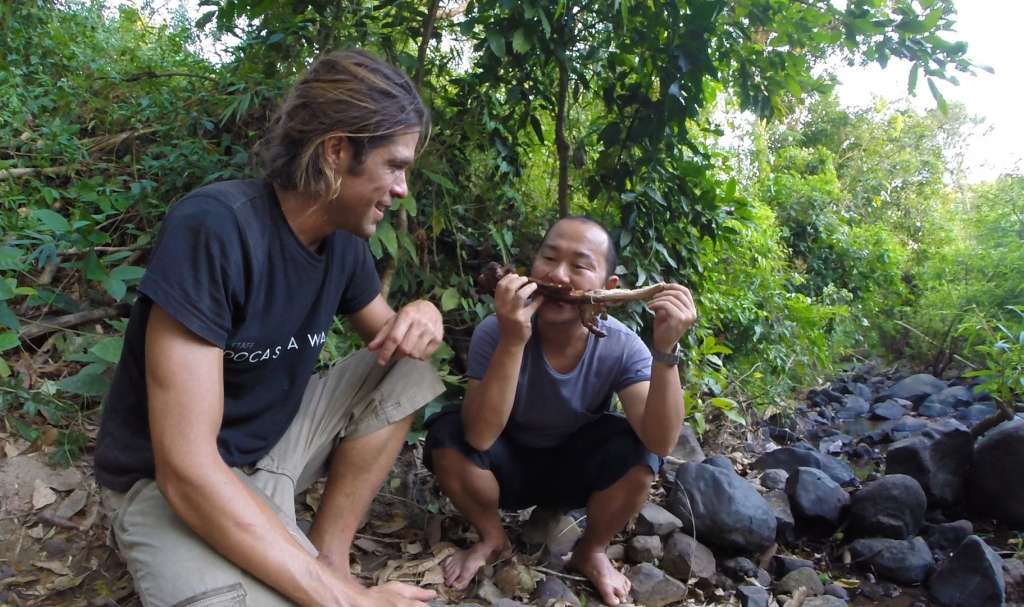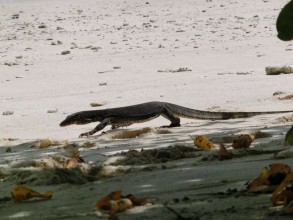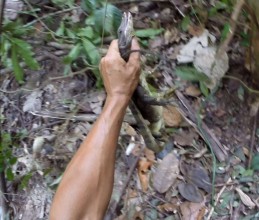In this article I will try to explain how to catch a monitor lizard on a desert island letting us change our diet should we find ourselves abandoned a long time. In the video below that was taken on one of our desert islands you can see all the process from the begining.
First we have to find three fine threads/rope of about 1.5 metres long (one for each trap). Should we only have one thread then we can only lay one trap. If there is no thread to hand we can use our footwear, but if we are barefoot then we’ll have to make our own thread with plant fibre (finding that making slip knots won’t be easy).
The next step will be to find the right place to set the trap. It has to be as far away from our refuge as possible as these reptiles usually keep as far away from humans as they can. However, they invariably go to the beach every day at some time, looking for any dead fish the tide brings in. So a place between the jungle and the beach is the best place to lay the trap.
Once the spot has been chosen we go on to gather plants and roots and try to surround a circular space placing the bait in the centre, but always leaving three open spaces where the lizard can get inside. By doing this we will be forcing it to pass through one of the three spaces where we will have laid our traps. The video explains how the mechanism of this trap works.
Once the trap has been built we have to place the bait, this can be the leftover or waste fish from the day. Should we not have caught any fish that day then we can use hermit crabs as they are easy to find around the beach.
What is important is to attract the lizards by strong smell as they just adore putrid fish, so the more putrid the bait the farther afield the smell will penetrate. It is important not to put the bait on the ground for two important reasons:
1 – The hermit crabs, mice and even lizards that have escaped the trap will finish off the bait in little time.
2 – The traps don’t always work when the lizard goes by, be it because it didn’t activate itself or because the cord loop didn’t quite catch any part of the lizard’s body. For these reasons we decided to make three entrance spaces with a trap in each one. We want the lizards to go in and out of each of the spaces various times thereby making it more difficult for them to pinpoint exactly where the fish is.
It’s better, therefore, that the bait is placed above ground level. We can us something as simple as a stick which we stake in the ground in the middle of the area chosen, and hang pieces of fish from the end. On the video, I used a piece of old bamboo.
Once the traps and bait are ready we’ll have to wait well away from the scene for at least the first 12 hours. The time it can take to trap our prey will depend on the number of lizards on the desert island and also on the grade of decay of the bait. As we mentioned before, the stronger the smell more chances there are to attract the lizard. If the fish/bait were fresh on the first day then it could take around 48 hours, which is what happened to me on the video.
I’VE CAUGHT ONE!
The question we ask ourselves when we find a lizard caught in the trap by its leg is how on earth do we grab it with our hands. Well really these animals are very easy to manage but we have to be careful not to let ourselves be bitten as the wound will instantly become infected. Also the lizard will use its tail like a whip so this has to be restrained as well. A strong hand on the neck and another on the tail will be sufficient.
The cleaning phase will be better carried out near water, at the edge of the sea or by a stream. First we have to chop the lizard’s neck with a machete. Then we cut off its clawed feet and the end of the tail, thought this is not an easy task without a well sharpened knife.
The hardest part is skinning the lizard as its skin is very well stuck to the body and will need a lot of pull strength. To make this easier first make a cut from the neck right down the body to the tail. Take advantage of this cut to clean out the viscera so all that is left is meat. Once we get to the tail give a strong pull on the skin and separate it completely from the body.
Now all we have to do is wash the meat and it’s ready for roasting. Look for thin, green bamboo and stick it through the ribs. Roast the meat as long as possible to kill off all possible bacteria.
Once it’s cooked, time to eat. And yes, you’re right, the monitor lizard also tastes like chicken! 😀
Our japanese castaway Reikko Hori caught a monitor lizard during the 19 days that she stayed alone on her desert island. But Reikko never used this technique but took advantages of the fact that the lizard was actually blind.
P.S: Our japanese castaway Reikko Hori caught a monitor lizard during the 19 days that she stayed alone on her desert island. Reikko never used this technique, instead she took advantages of the fact that the lizard was actually blind.
By the way, have you tried lizard meat before which tasted different from chicken? Have you any advice on how to better my traps? Please tell me about it below.








{ 6 comments… read them below or add one }
Nice one!
Just bought one big Monitor on the street that was killed with stones by some kids here in Zambia and wondered hof to prepare it.
I will have it tomorrow 🙂
One question: can I do anything nice with the beautiful skin?
Thank you for the post!
yours Noah
Sorry but I haven´t found any utility to the skin yet 🙂
Sorry but I haven´t found any utility to the skin yet 🙂
What happens to the intestines? This evening, kids were selling one but I couldn’t buy for I did know what to do with it. Suzio, in Ndola Zambia
What happens to the intestines? This evening, kids were selling one but I couldn’t buy for I did not know what to do with it. Suzio, in Ndola Zambia
YOu can eat them as well!!